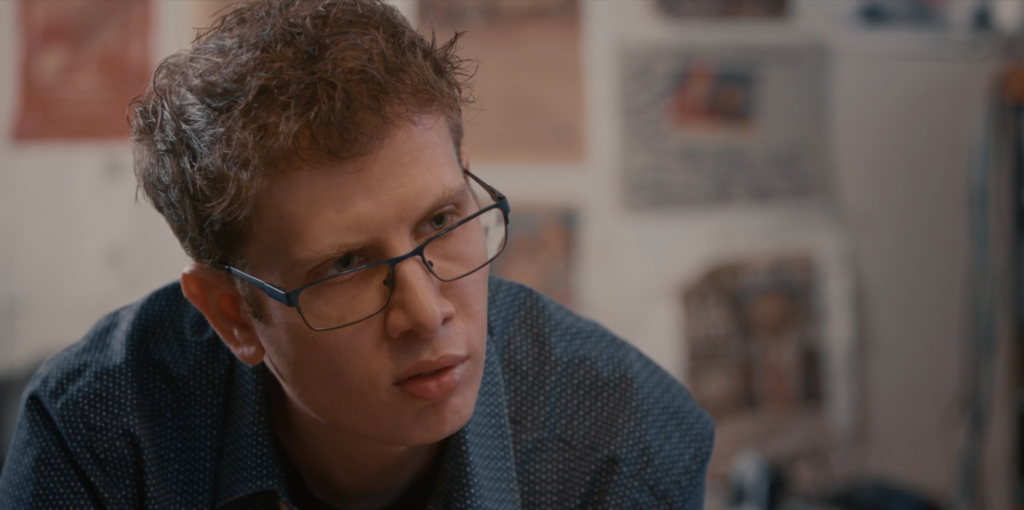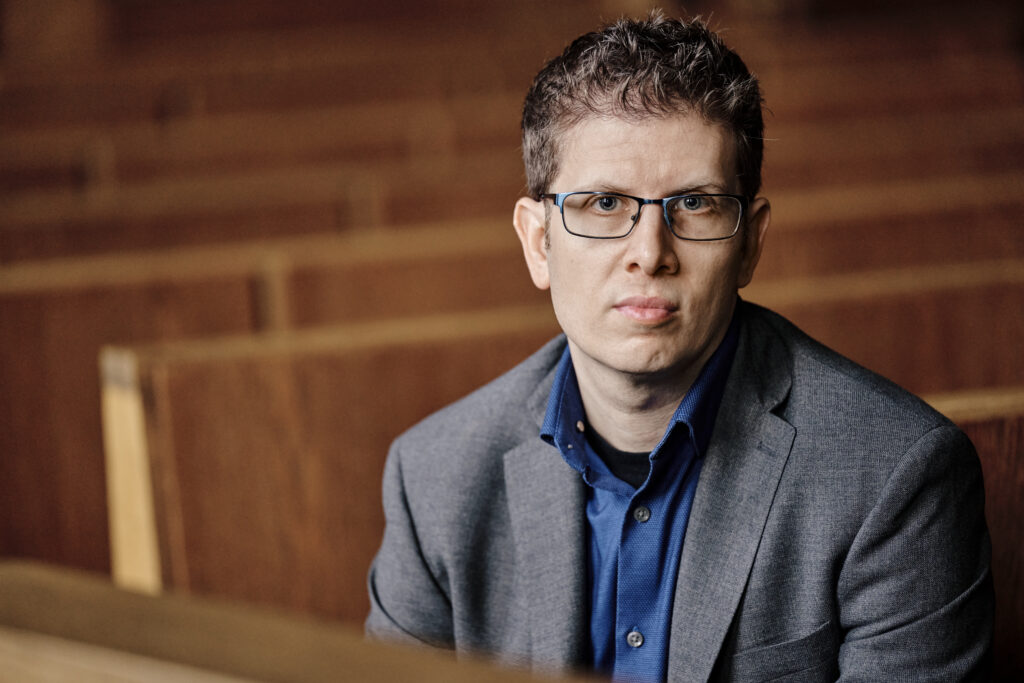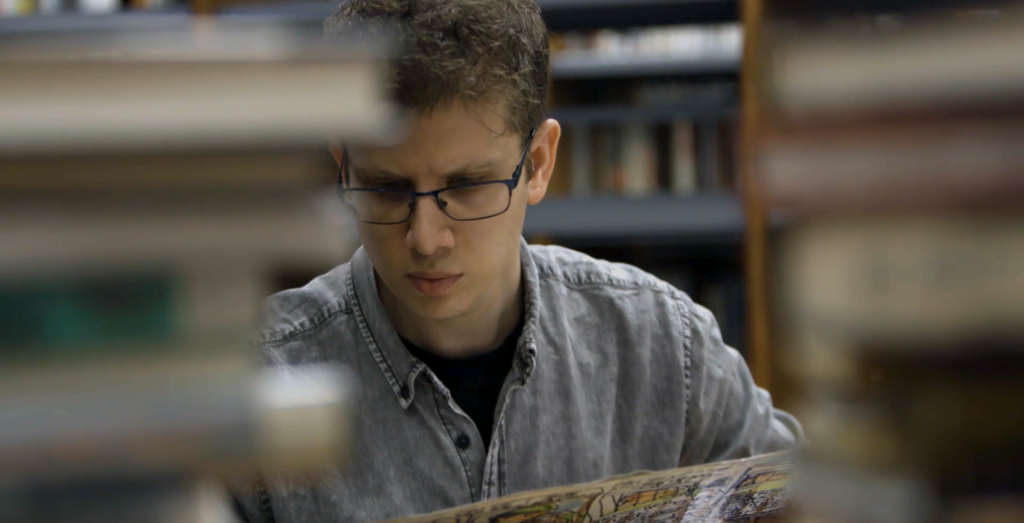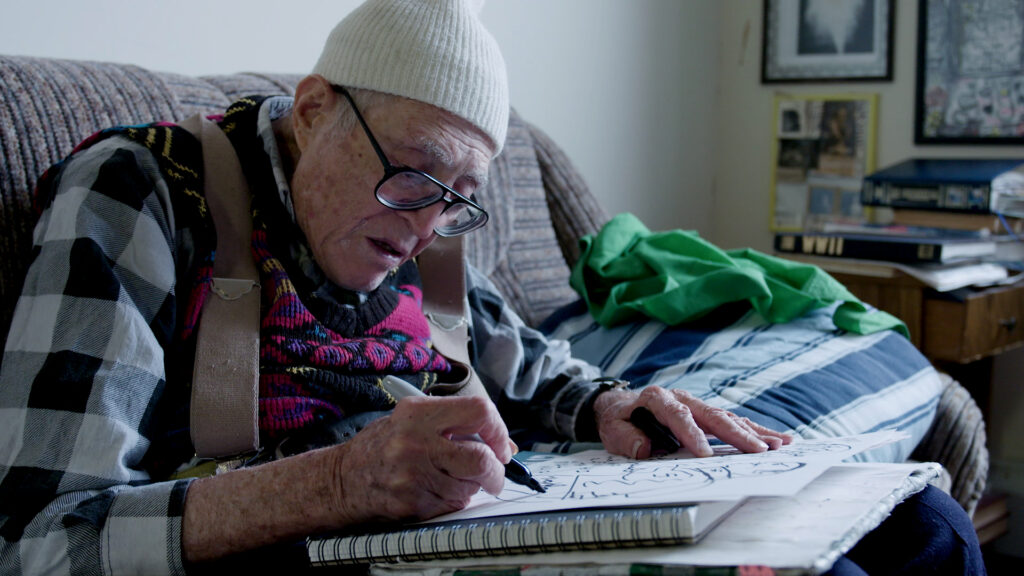Jaylan Salah, after reviewing Nathan-ism briefly interviewed the director, Elan Golod.

Jaylan Salah: What compelled you to take on this story?
Elan Golod: When I first stumbled upon an article about a retrospective exhibition of Nathan Hilu’s artwork, I was immediately captivated by the circumstances of his experiences serving as a G.I. guard at the Nuremberg Trials. I was also intrigued by the visual richness that Nathan’s vibrant artwork could bring to a cinematic portrayal of this remarkable narrative. When you initially are confronted with Nathan’s artwork, there’s this intriguing clash – a sort of cognitive dissonance – between the weighty themes he addresses and the lively, almost childlike, style of his art. That felt inherently cinematic to me.
JS: What do you think is the role of documentarians as archive keepers of history?
EG: I think documentarians play a crucial role in providing context and perspective to historical events, helping society understand the complexities of the past and its impact on the present. Documentary films can help amplify voices that may otherwise be marginalized or forgotten. By sharing stories like Nathan Hilu’s, I hope filmmakers like myself can facilitate dialogue and reflection, encouraging audiences to engage critically with the past and its implications for the future.

JS: How did you find approaching Nathan Hilu for this project? How were your interactions with him?
EG: Initially, when I cold-called Nathan to discuss my interest in his story, he seemed hesitant to open up. About 15 years prior, another team had approached him with plans to create a book about his experiences, but unfortunately, that project never materialized, leaving Nathan somewhat jaded. Despite his initial reservations, Nathan eventually agreed to let me visit him. Over several visits, I worked on building a rapport, gradually fostering a sense of trust and comfort between us. It was during this process that Nathan began to feel more relaxed and, eventually, agreed to participate in the filming of the documentary.
As our relationship developed, Nathan became increasingly comfortable in front of the camera. Over time, his initial reservations transformed into genuine enthusiasm for the filmmaking process. Despite his enthusiasm for the process, our filming sessions were far from typical interviews and felt more like a “show-and-tell” experience – Nathan would eagerly share the stories behind his latest drawings. It was tricky to get a word in edgewise with Nathan, but here and there I was able to guide the conversation towards the themes I wanted to explore.
JS: How difficult was it to visit such a dark time in the history of humanity such as the Holocaust?
EG: When starting this journey with Nathan Hilu, I didn’t set out to make a run of the mill Holocaust film. I was however fascinated by the opportunity Nathan offered to explore this weighty subject
from a fresh perspective that certain audiences might find more accessible. Wherever possible, I think it’s crucial to find ways to expand the conversation about the Holocaust in order to prevent the world from turning a blind eye to the lessons of the past.
Through Nathan’s story and others like it, we have an opportunity to prevent indifference and ensure that the profound significance of the Holocaust remains ingrained in our collective consciousness.

JS: Some of the montages cut between Hilu’s paintings and archival videos and photos were brilliantly assembled. How did you come up with the style for the documentary?
EG: The stylistic approach was born out of extensive experimentation in the editing process. At its core, our aim was to create a dynamic juxtaposition between Nathan’s subjective storytelling and the ostensibly more concrete, “objective” evidence provided by archival videos and photographs.
Through this intertwining we found we were able to inject layers of meaning and depth into the narrative. The drawings served as a visual representation of Nathan’s interpretation of events, while the archival footage and photographs grounded the story in the tangible reality of historical record. This juxtaposition allowed us to blur the lines between subjective interpretation and objective evidence, inviting viewers to consider multiple perspectives and engage with the narrative on a more nuanced level.
JS: As a storyteller, what is the most important theme that you want audiences to take from your film?
EG: I think the most actionable takeaway I would like audiences to take from the film is the imperative to take the time and listen to our elders. In today’s fast-paced world we risk overlooking the invaluable insights and experiences our older generations possess. By taking the time to truly listen and absorb the lessons they offer, we not only honor their lived experiences but also enrich our own lives. Their stories carry the weight of history and offer invaluable perspectives that can guide us in navigating the complexities of the present and shaping a better future. I think fostering intergenerational dialogue and cherishing the knowledge passed down from our elders can help us build a more empathetic and understanding society.
JS: Which were the most difficult scenes to shoot?
EG: By far the most tense and challenging scene to film was a pivotal confrontation where I had to challenge Nathan on certain aspects of his story.
This scene demanded a lot of sensitivity from both myself and my team. We recognized the importance of approaching the confrontation with a mindset of inquiry rather than judgment. Our goal was not to put Nathan’s recollections on trial but rather to delve beneath the surface, seeking a more profound understanding of the story he was sharing.
Throughout the filming process, we remained acutely aware of the emotional stakes involved. We understood the potential impact of our questions on Nathan’s psyche and the integrity of his narrative. Ultimately, it was our commitment to empathy and understanding that enabled us to navigate this challenging scene successfully. The result was a scene that not only added depth to the documentary but also underscored the complexities of storytelling and memory.
JS: What do you think is the artist’s duty toward the world? How do you think the work of an artist is comparable to a philanthropist or a missionary?
EG: I think artists have the power to contribute to cultural dialogue and provoke thought, inspiring change and progress. Like philanthropists, artists share a common goal of improving society, albeit through different means. While philanthropists may provide material support and resources to address social issues directly, artists address these issues by raising awareness, challenging norms, and inspiring action through their creative expression.

JS: Do you prefer the medium of documentary filmmaking to feature films in terms of telling an inspirational story based on/semi-based on an impactful real-life story? What do you think is the main difference between both media?
EG: When it comes to telling an inspirational story based on an impactful real-life event, I believe both documentary filmmaking and scripted films have their own strengths and limitations. I tend to prefer the more raw and unfiltered depiction of real-life events, providing audiences with a sense of immediacy and authenticity. As an editor, I also relish the process of discovery in the edit room. I recognize that scripted films have the ability to distill complex narratives into a cohesive and emotionally resonant story, using cinematic techniques such as visual storytelling and character arc development to engage viewers on a deeper level. Ultimately, the choice between the two mediums depends on the specific story being told and the filmmaker’s creative vision.
JS: What are you working on after the widespread acclaim for Nathan-ism?
EG: I am currently working on a short documentary about an artist within my own family while also doing research for a larger film project. These projects are both continuing my exploration of the intricacies of artistic legacy.





